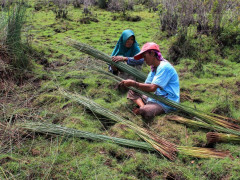Observing the Oil Palm Plantations’ Circle of Conflict in Central Kalimantan
By Dimas N. HartonoPerhutanan Sosial di Gambut Riau

Sejumlah kelompok masyarakat telah mengajukan permohonan Perhutanan Sosial (PS) di wilayah gambut, Mereka berharap skema pengelolaan ini dapat mendorong upaya pemanfaatan potensi ekosistem gambut untuk peningkatan kesejahteraan warga. Pengajuan ini masih tersendat karena harus menunggu peraturan terkait PS di gambut.
Riau is one of the provinces for the implementation of the Social Forestry (SF) policy, which is a community-based forest management program and is one of the national strategic projects. In the SF program for the 2015 – 2019 period, the government allocated forest areas covered in the Indicative Map for Social Forestry (PIAPS) with a total of 12.7 million hectares. There are five schemes in Social Forestry, namely Village Forest, Community Forest, Customary Forest, Community Plantation Forest and Forestry Partnership.
Of the total PIAPS, an area of 1.4 million ha is in Riau. However, from the developments up to the fourth year, the realization of this Social Forestry is only around 82 thousand hectares for Riau until September 2018. This means that only 6 percent has been achieved.
Previously, a number of civil society groups submitted applications for SF permit, such as the Jaringan Masyarakat Gambut Riau (JMGR, in English: Riau Peat Community Network) which assisted dozens of villages in submitting this management scheme. Through JMGR, around 52 thousand ha of land, or the equivalent of 1.5 times the area of Surabaya City, of peat and mangrove areas are requested by the residents to be managed collectively. From this amount, only around 21 thousand ha were proposed for technical verification.
JMGR Secretary General Isnadi Esman talked about the people of Rawa Mekar Jaya Village, Siak Regency, who have been waiting since December 2016. This is even after it has reached the technical verification stage which was carried out in August 2017.
"[The proposal for the] Rawa Mekar Jaya Village Forest covering an area of 4,970 hectares has been verified in August 2017. Until now there has been no progress. This has been reported to the Ministry of Environment and Forestry (KLHK) and Peatland Restoration Agency (BRG). The reason is that there is no Ministerial Regulation that regulates Social Forestry on peat," said Isnadi.
The Director General of Social Forestry and Environmental Partnership, KLHK, Bambang Supriyanto acknowledged that SF signatories on peat must still wait for the Regulation of the Minister of Environment and Forestry which specifically regulates SF in peat ecosystems. Bambang was present at the Jikalahari discussion on Monday, 11 December 2018, afternoon in Pekanbaru. He explained the complex obstacles his directorate general is currently facing in relation to the implementation of SF in Riau.
According to Bambang, the absence of SF regulations on peat is part of the serious obstacles in the implementation of this policy, which also include obstacles to bureaucracy, law and differences in perceptions of derivative institutions in the regions.
"Social Forestry in Riau is constrained by regulations and the overlapping of national level regulations with regional level regulations," he said.
Bambang referred to Regional Regulation Number 10 of 2018 concerning the Riau Province Regional Spatial Plan. In articles 46 and 47 of this regulation, the Regional People's Representative Council of Riau and the Governor of Riau must be involved in the process of filing and verifying Social Forestry. This problem of inter-agency coordination is seen as hampering the Social Forestry Working Group and the technical verification team so that proposals that have been submitted and verified cannot be further processed for signing.
On the other hand, the BRG, which was formed to coordinate the restoration of 2 million ha of peatlands, has stated that the restoration program needs to support social forestry policies.
Judging from the related regulations, namely Minister of Environment and Forestry Regulation Number P.83/MENLHK/SETEJN/KUM.1/10/2016 concerning Social Forestry, Social Forestry managers will have various obligations, including protecting the area from environmental destruction and pollution, maintaining forest functions and carrying out forest protection.
Based on this obligation, SF in peatlands must also pay attention to protection factors and restoration efforts. This is necessary to avoid misuse of peatlands through Social Forestry schemes, such as the new land openings on peatlands.



